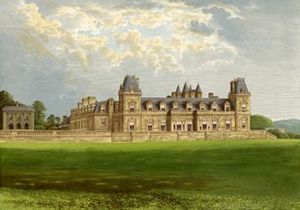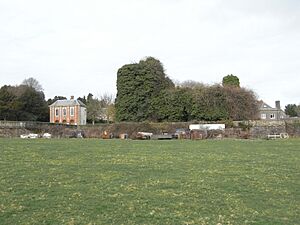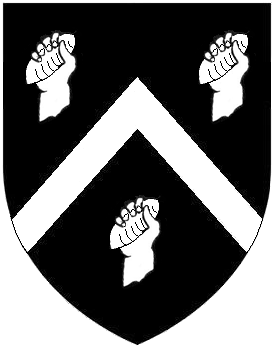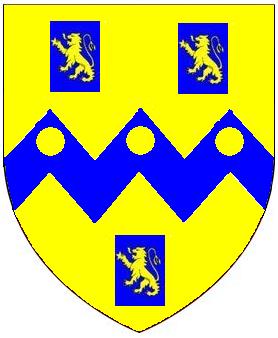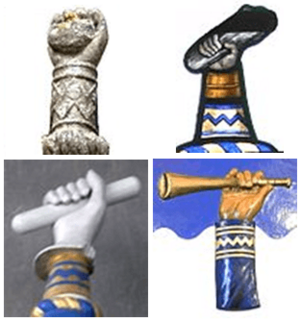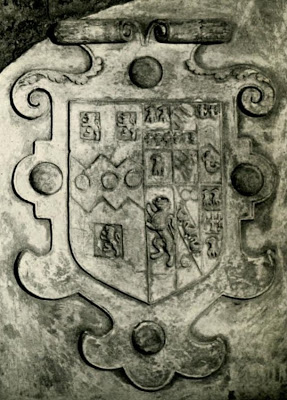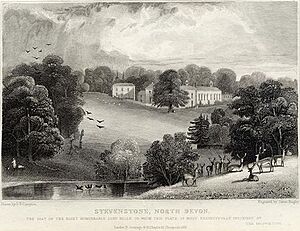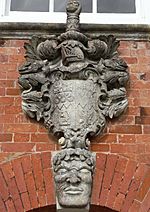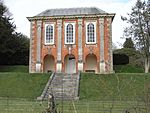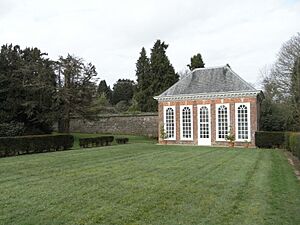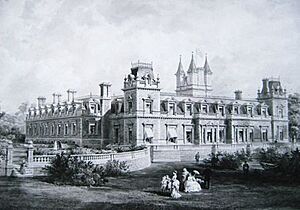Stevenstone facts for kids
Stevenstone was once a large estate, or manor, located near Great Torrington in North Devon, England. It was the main home of the Rolle family, who were one of Devon's richest and most powerful families. They lived there from about 1524 until 1907.
The Rolle family owned a huge amount of land. In 1873, their estates covered over 55,000 acres! This made them the largest landowners in Devon. Their wealth came from these lands, bringing in a lot of money each year.
From 1688 to 1832, only about ten powerful families, including the Rolles, chose the county's representatives in Parliament. The Rolles were not from old noble families like some others. Instead, they came from a clever lawyer and administrator from the Tudor period.
The Rolles, like the Russell family (who later became Dukes of Bedford), gained a lot of land that used to belong to monasteries. This happened after King Henry VIII closed down the monasteries in the 1500s. Some historians believe the Rolles eventually owned even more land than the Russells.
In 1669, Sir John Rolle, who lived at Stevenstone, had an income of £6,000 a year. This made him one of the wealthiest people in the country. When he died in 1706, he owned more than 40 manors in Devon.
The Rolle family built several different houses on the Stevenstone site over the years. The last big house was built between 1868 and 1872. It was later made much smaller after 1912. Then, after 1931, it was slowly taken apart, piece by piece, for its building materials.
Contents
Stevenstone's Early Owners
A historian named John Prince wrote about the early owners of Stevenstone. The first recorded owner was Michael de Stephans. He gave the manor to Richard Basset, whose son Elias Basset then gave it to Walter de la Lay.
Later, a descendant named John de Lay changed his name to John de Stephenston. Another Elias Basset, who was a powerful lord, gave up his claim to Stevenstone, leaving it fully to John de Stevenstone.
The manor then passed through several more generations of the Stephenston family. The last of them, John de Stephenston, had a daughter named Elizabeth. She inherited the manor and brought it to her husband, Grant of Westlegh, when they married.
The Grant family also had no sons, so the manor was divided between two daughters. One married into the Monk family, and the other married a member of the Moyle family. The Moyle family received Stevenstone and made it their main home.
The Rolle Family Takes Over
George Rolle (who died in 1552) bought the Stevenstone estate shortly before 1524. He was the person who started the Rolle family's power in Devon. George Rolle was probably born in Dorset. He became a very successful lawyer in London.
He worked for many important people and even for some monasteries in Devon. He also served as a Member of Parliament (MP) for Barnstaple in 1542 and 1545.
Many of George Rolle's male descendants became Members of Parliament. The last male in the main line of the family was John Rolle, 1st Baron Rolle (1750-1842). He died without any children.
The Stevenstone estate, along with many other lands the family had bought, eventually went to Sir John Rolle (1626-1706). He was a grandson of George Rolle's second son.
Key Rolle Family Members
Here are some important members of the Rolle family who owned Stevenstone:
- George Rolle (died 1552): He bought Stevenstone before 1524 and started the family's wealth.
- John Rolle (1522–1570): George's oldest son.
- Sir Henry Rolle (1545-1625): John's oldest son. He owned a townhouse in Exeter called "Abbot's Lodge." This house had been bought by his grandfather, George Rolle, after the monasteries were closed. Sir Henry added decorations to the house, including his family's coat of arms.
- Denys Rolle (1614–1638): Sir Henry's grandson. He was known as "The darling of his country" because he was so well-liked and talented.
- John Rolle (1638-1642): Denys's only son, who died as a baby.
- Sir John Rolle (1626-1706): A cousin who inherited Stevenstone. He was a Member of Parliament and owned over 40 manors in Devon. In 1669, he had a huge income of £6,000 a year. He even hosted a Grand Duke from Tuscany at his Exeter home!
- Robert Rolle (1677-1710): Sir John's grandson.
- John Rolle (1679-1730): Robert's brother.
- Henry Rolle, 1st Baron Rolle (1708-1750): John's oldest son.
- John Rolle Walter (1712-1779): Henry's brother.
- Denys Rolle (1725–1797): John's brother. He was an MP and even started colonies in Florida and the Bahamas!
- John Rolle, 1st Baron Rolle (1750-1842): Denys's son. He was the last male in the main Rolle family line and had no children.
- Mark Rolle (1835-1907): He was adopted by Lord Rolle's wife and became the heir to the estates.
Stevenstone House Through Time
The earliest description of Stevenstone House comes from John Leland, who wrote in the 1500s that George Rolle had built "a right fair house of bryke" (a very nice brick house). This was likely the first brick house in Devon!
Two beautiful buildings, an Orangery (a type of greenhouse for orange trees) and a "Library Room," were built next to the main house. These were built by John Rolle (1679-1730). The Library building has a stone carving above its arch showing the Rolle family's coat of arms combined with his wife's family, the Walters.
The main house itself was rebuilt or updated in the 1700s. An old picture from 1831 shows what this Georgian-style house looked like.
The Victorian Re-build
In 1868, Mark Rolle decided to tear down the old house. In its place, between 1868 and 1872, he built a huge new Victorian mansion. It was designed by Charles Barry Jr. and was built in a style called "French Chateau style."
Many people today think this Victorian house was not very beautiful. One historian, Hoskins, wrote in 1954 that Mark Rolle, "The richest man in Devon built himself the ugliest house." The house was set within a large deer park of 370 acres, filled with many valuable trees.
Sale and Demolition
New Owners: The Clintons and Clemsons
After Mark Rolle died in 1907, the vast Rolle estates, which were about 55,000 acres, passed to his nephew, Charles John Robert Hepburn-Stuart-Forbes-Trefusis, 21st Baron Clinton.
Lord Clinton then sold Stevenstone by auction in 1912 to Captain John Oliver Clemson and his wealthy wife, Mary McKinnon. The Clemsons decided to make the huge house smaller. They tore down about half of the east side, including the main tower. They likely did this because it was hard to find enough staff to manage such a large house, especially during wartime.
Captain Clemson was a Master of the Stevenstone Foxhounds, a local hunting group. He was called to fight in World War I in 1914 and sadly died from his wounds in Gallipoli in 1915. A monument in St Giles' Church remembers him. His wife, Mary, later put up a bronze memorial in the church for the twelve men from the parish who died in World War I.
The House is Taken Apart
In 1930 and 1931, the Stevenstone estate was put up for sale again. The house itself, with only 17 acres of land, failed to sell for £3,000.
In 1931, a local farmer named George Millman bought the house and some parkland. He planned to sell the house for its building materials, piece by piece. He even had an auction planned to sell it in 609 separate lots! However, he changed his mind and tried to buy back as many parts as he could.
The house remained standing for a few more years, though it was made smaller again when the servants' wing was removed. During World War II, soldiers from the Warwickshire Regiment and later American troops were stationed there.
After the war, Mr. Millman sold the house to Mr. Melville. Mr. Melville then went ahead with the demolition. He used much of the stone from the house to turn the old stable block into terraced homes. He also built several smaller houses and bungalows nearby.
In 1970, the remaining ruins of Stevenstone House were bought by Mr. Parnell. Even though the nearby Library Room and Orangery were protected as "Grade II* Listed" buildings in 1960, the ruins of the main house only received "Grade II Listing" in 1989. This protects them from being completely demolished, but they have continued to decay and are now covered in ivy.
Stevenstone Today
Today, around the ruined house, there is a small community. You can find the terraced houses that were once the stable block, several bungalows built in the old walled garden, and other new homes. The local fox hunt, the Torrington Farmers Hunt, also has its kennels there.
The old Library Room and the Orangery, which are still beautiful Palladian buildings, were bought by the Landmark Trust in 1978. They have been restored and are now rented out to people who want to stay in unique historic places.


